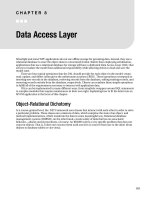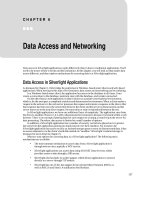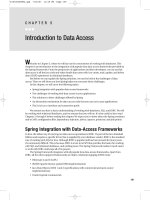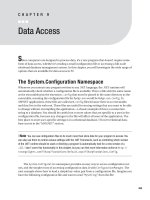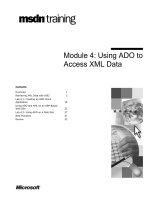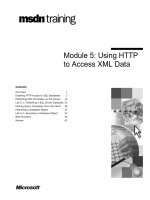Data Access
Bạn đang xem bản rút gọn của tài liệu. Xem và tải ngay bản đầy đủ của tài liệu tại đây (368.62 KB, 30 trang )
Data Access
S
ince computers are designed to process data, it’s a rare program that doesn’t require some
form of data access, whether it’s reading a small configuration file or accessing a full-scale
relational database management system. In this chapter, you will investigate the wide range of
options that are available for data access in F#.
The System.Configuration Namespace
Whenever you execute any program written in any .NET language, the .NET runtime will
automatically check whether a configuration file is available. This is a file with the same name
as the executable plus the extension
.config that must be placed in the same directory as the
executable, meaning the configuration file for
MyApp.exe would be MyApp.exe.config. In
ASP.NET applications, these files are called
web.config files because there is no executable,
and they live in the web root. These files are useful for storing settings that you want to be able
to change without recompiling the application—a classic example of this is a connection
string to a database. You should be careful not to store values that are specific to a user in the
configuration file, because any changes to the file will affect all users of the application. The
best place to store user-specific settings is in a relational database. I’ll cover relational data-
base access in the “ADO.NET” section.
■
Note
You can use configuration files to do much more than store data for your program to access. You
can also use them to control various settings with the .NET Framework, such as controlling which version
of the .NET runtime should be used or directing a program to automatically look for a new version of a
.dll
. I don’t cover this functionality in this chapter, but you can find more information online at
http://
strangelights.com/FSharp/Foundations/default.aspx/FSharpFoundations.Config
.
The System.Configuration namespace provides an easy way to access configuration val-
ues, and the simplest way of accessing configuration data is with
ConfigurationManager. The
next example shows how to load a simple key-value pair from a configuration file. Imagine you
have the following configuration file and want to read
"MySetting" from the file:
209
CHAPTER 9
■ ■ ■
7575Ch09.qxp 4/27/07 1:05 PM Page 209
<configuration>
<appSettings>
<add key="MySetting" value="An important string" />
</appSettings>
</configuration>
The following code loads the setting by using ConfigurationManager’s static AppSettings
property:
#light
#r "System.Configuration.dll";;
open System.Configuration
let setting = ConfigurationManager.AppSettings.Item("MySetting")
print_string setting
The result is as follows:
An important string
■
Note
The way to access these values in .NET version 1.1 was through the
ConfigurationSettings
type
in
System.dll
. This type is still available in .NET 2.0 but has been depreciated, so it is best to avoid using it.
Since the most common use for these name-value pairs is to store connection strings, it is
customary to use a separate section specifically for this purpose to help separate them from
other configuration settings. The
providerName property allows you to store information about
which database provider the connection string should be used with. The next example shows
how to load the connection string
"MyConnectionString" from the following configuration file:
<configuration>
<connectionStrings>
<add
name="MyConnectionString"
connectionString=" Data Source=server;
Initial Catalog=pubs;
Integrated Security=SSPI;"
providerName="System.Data.SqlClient" />
</connectionStrings>
</configuration>
The follo
wing example loads the connection str
ing via another static property on the
ConfigurationManager class
, the
ConnectionString pr
oper
ty
.
This is a collection that giv
es
access to a type called
ConnectionStringSettings, which has a ConnectionString pr
oper
ty
CHAPTER 9
■
DATA ACCESS
210
7575Ch09.qxp 4/27/07 1:05 PM Page 210
giving access to the connection string and a ProviderName property giving access to the
provider name string.
#light
#r "System.Configuration.dll";;
let connectionStringDetails =
ConfigurationManager.ConnectionStrings.Item("MyConnectionString")
let connectionString = connectionStringDetails.ConnectionString
let providerName = connectionStringDetails.ProviderName
printfn "%s\r\n%s"
connectionString
providerName
The results are as follows:
Data Source=server;
Initial Catalog=pubs;
Integrated Security=SSPI;
System.Data.SqlClient
■
Caution
Notice that because I added spaces and newline characters to the configuration file to improve
the formatting, these were also added to the connection string, which can be seen when output to the con-
sole. Most libraries consuming the connection string will correct for this, but some may not, so be careful
when formatting your configuration file.
You’ll explore the possibility of choosing between different relational databases at runtime
in “The EntLib Data Access Block” section later in this chapter.
It’s also possible to load configuration files associated with other programs or web appli-
cations and even
machine.config, which contains the default settings for .NET on a particular
machine
. These files can be queried, updated, and then saved. The following sample shows
how to open
machine.config and enumerate the various sections within it:
#light
#r "System.Configuration.dll";;
let config =
ConfigurationManager.OpenMachineConfiguration()
for x in config.Sections do
print_endline x.SectionInformation.Name
The r
esults
, when executed on my machine
, are as follows:
CHAPTER 9
■
DATA ACCESS
211
7575Ch09.qxp 4/27/07 1:05 PM Page 211
system.data
windows
system.webServer
mscorlib
system.data.oledb
system.data.oracleclient
system.data.sqlclient
configProtectedData
satelliteassemblies
system.data.dataset
startup
system.data.odbc
system.diagnostics
runtime
system.codedom
system.runtime.remoting
connectionStrings
assemblyBinding
appSettings
system.windows.forms
This section has shown how to work with configuration files, a particular kind of XML file.
The next section will show how to use the
System.Xml namespace to work with any kind of
XML file.
The System.IO Namespace
The main purpose of the System.IO namespace is to provide types that give easy access to the
files and directories of the operating system’s file store, although it also provides ways of writ-
ing to memory and network streams too.
The namespace offers two main ways to deal with files and dir
ectories.
FileInfo and
DirectoryInfo objects are used to get or alter information about a file or directory. There are
also
File and Directory classes that offer the same functionality but that are exposed as static
members that require the filename to be passed to each method. Generally, you will use the
File and Directory classes if you want a single piece of information about a file system object
and use the
FileInfo and DirectoryInfo classes if you need lots of information about a single
file system object. The two techniques are complementary; for example, you might use the
Directory type to get information about all the files in a directory and then use the FileInfo
object to find out the name and other information about the file. Here’s an example of doing
this:
#light
open System.IO
let files = Directory.GetFiles(@"c:\")
CHAPTER 9
■
DATA ACCESS
212
7575Ch09.qxp 4/27/07 1:05 PM Page 212
for filepath in files do
let file = new FileInfo(filepath)
printfn "%s\t%d\t%O"
file.Name
file.Length
file.CreationTime
The results, when executed on my machine, are as follows:
addadmin.bat 95 01/10/2003 02:08:10
ATTDialer.doc 297472 03/11/2003 20:12:54
AUTOEXEC.BAT 0 12/05/2003 20:21:21
avapower.gif 1056 07/07/2004 01:27:05
boot.ini 211 12/05/2003 12:58:01
CONFIG.SYS 0 12/05/2003 20:21:21
dpst.bat 17 01/10/2003 02:08:10
imagefaq.bat 21 01/10/2003 02:08:10
IO.SYS 0 12/05/2003 20:21:22
MSDOS.SYS 0 12/05/2003 20:21:22
NTDETECT.COM 47564 23/08/2001 14:00:00
Ntldr 250032 23/08/2001 14:00:00
NavCClt.Log 35152 13/05/2003 00:44:02
The namespace also provides an extremely convenient way to work with the contents of
files. Files are open and are represented as streams, which provide a way to read or write bytes,
characters, or strings from a file. Opening a file and reading text from it could not be simpler—
just call the
File.OpenText method, and you get access to a StreamReader object that allows
you to read the file line by line. The following example demonstrates reading a comma-
separated file, containing three columns of data:
#light
open System.IO
//test.csv:
//Apples,12,25
//Oranges,12,25
//Bananas,12,25
using (File.OpenText("test.csv"))
(fun f ->
while not f.EndOfStream do
let line = f.ReadLine()
let items = line.Split([|','|])
printfn "%O %O %O"
items.[0]
items.[1]
items.[2])
The r
esults
, when executed with the text file in the comments
, are as follows:
CHAPTER 9
■
DATA ACCESS
213
7575Ch09.qxp 4/27/07 1:05 PM Page 213
Apples 12 25
Oranges 12 25
Bananas 12 25
■
Note
The
File
.
OpenText
method assumes your file has a UTF-8 encoding. If your file does not use this
text encoding, you should call the
OpenRead
method and then wrap the resulting
FileStream
object in a
StreamReader
, passing in the appropriated encoding object. For example, if your file used the encoding
Windows-1252 for Western languages, you should open it via
new StreamReader(File.OpenRead
("accents.txt"), Encoding.GetEncoding(1252))
.
The System.Xml Namespace
XML has become a popular data format for a number of reasons, probably because for most
people it is a convenient format to represent their data and because the resulting files tend to
be reasonably human readable. Programmers tend to like that you can have both files be
unstructured (that is, don’t follow a set pattern) or have the files be structured and have the
data conform to a contract defined by an
XSD schema. Programmers also like the convenience
of being able to query the data using
XPath, which means that writing custom parsers for new
data formats is rarely necessary, and files can quickly be converted between different XML for-
mats using the powerful
XSLT language to transform data.
The
System.Xml namespace contains classes for working with XML files using all the differ-
ent technologies I have described and more besides this. You’ll look at the most common way to
work with XML files—the .NET implementation of the W3C recommendation for the XML
Document Object Model (DOM), which is generally represented by the class
XmlDocument. The
first example in this section will read information from the following short XML file,
fruits.xml:
<fruits>
<apples>2</apples>
< oranges >3</oranges>
<bananas>1</bananas>
</fruits>
The following code loads fruits.xml, binds it to the identifier fruitsDoc, and then uses a
loop to display the data:
#light
open System.Xml
let fruitsDoc =
let temp = new XmlDocument()
temp.Load("fruits.xml")
temp
CHAPTER 9
■
DATA ACCESS
214
7575Ch09.qxp 4/27/07 1:05 PM Page 214
let fruits = fruitsDoc.SelectNodes("/fruits/*")
for x in fruits do
printfn "%s = %s " x.Name x.InnerText
T
he results are as follows:
apples = 2
oranges = 3
bananas = 1
The next example looks at how to build up an XML document and then write it to disk.
Say you have a set of data, bound to the identifier
animals, and you’d like to write it as XML
to the file
animals.xml. You start by creating a new XmlDocument object, and then you build
the document by creating the root node via a call to the
XmlDocument instance member
CreateElement method and then append to the document object using its AppendChild
method. The rest of the document is built up by enumerating over the animals list and
creating and appending nodes.
#light
open System.Xml
let animals = [ "ants", "6"; "spiders", "8"; "cats", "4" ]
let animalsDoc =
let temp = new XmlDocument()
let root = temp.CreateElement("animals")
temp.AppendChild(root) |> ignore
animals
|> List.iter (fun x ->
let element = temp.CreateElement(fst x)
element.InnerText <- (snd x)
root.AppendChild(element) |> ignore )
temp
animalsDoc.Save("animals.xml")
The result of this code is a file
,
animals.xml, containing the following XML document:
<animals>
<ants>6</ants>
<spiders>8</spiders>
<cats>4</cats>
</animals>
The System.Xml namespace is large, with many interesting classes to help you work with
XML data. Table 9-1 describes some of the most useful ones.
CHAPTER 9
■
DATA ACCESS
215
7575Ch09.qxp 4/27/07 1:05 PM Page 215
Table 9-1. Summary of Useful Classes from the System.XML Namespace
Class Description
System.Xml.XmlDocument The Microsoft .NET implementation of the W3C’s
XML DOM.
System.Xml.XmlNode This class can’t be created directly but is often
used; it is the result of the
XmlDocument’s
SelectSingle node method.
System.Xml.XmlNodeList This class is a collection of nodes and is the result
of the
XmlDocument’s SelectNode method.
System.Xml.XmlTextReader This provides forward-only, read-only access to an
XML document. Although not as easy to use as the
XmlDocument class, it does not require the whole
document to be loaded into memory. When
working with big documents, it can often provide
better performance than the
XmlDocument.
System.Xml.XmlTextWriter This class provides a forward-only way to write to
an XML document. If you must start your XML
document from scratch, this is often the easiest
way to create it.
System.Xml.Schema.XmlSchema This provides a way of loading an XML schema
into memory and then allows the user to validate
XML documents with it.
System.Xml.Serialization.XmlSerializer This allows a user to serialize .NET objects directly
to and from XML. However, unlike the
BinarySerializer available elsewhere in the
framework, this class serializes only public fields.
System.Xml.XPath.XPathDocument This class is designed to be the most efficient way
to work with XPath expressions. This class is just
the wrapper for the XML document; the
programmer must use the
XPathExpression and
XPathNavigator to actually do the work.
System.Xml.XPath.XPathExpression This class represents an XPath expression to be
used with an
XPathDocument; it can be compiled to
make it more efficient when used repeatedly.
System.Xml.XPath.XPathNavigator Once an XPathExpression has been executed
against the
XPathDocument, this class can be used to
navigate the r
esults; the adv
antage of this class is
that it pulls only one node at a time into memory,
making it efficient in ter
ms of memory.
System.Xml.Xsl.XslTransform This class can be used to transform XML using
XSLT style sheets.
ADO.NET
Relational database
management systems ar
e the most pervasive form of data storage. ADO.NET,
in
System.Data and associated namespaces, makes it easy to access relational data. In this section,
you’ll look at various ways you can use F# with ADO.NET.
CHAPTER 9
■
DATA ACCESS
216
7575Ch09.qxp 4/27/07 1:05 PM Page 216
■
Note
All database providers use a connection string to specify the database to which to connect. You can
find a nice summary of the connection strings you need to know at
.
All examples in this section use the AdventureWorks sample database and SQL Server
2005 Express Edition, both freely available for download from
. It
should be easy to port these samples to other relational databases. To use this database with
SQL Server 2005 Express Edition, you can use the following connection settings or an adapta-
tion of them appropriate to your system:
<connectionStrings>
<add
name="MyConnection"
connectionString="
Database=AdventureWorks;
Server=.\SQLExpress;
Integrated Security=SSPI;
AttachDbFilename=
C:\Program Files\Microsoft SQL Server\MSSQL.1\MSSQL\Data\AdventureWorks_Data.mdf"
providerName="System.Data.SqlClient" />
</connectionStrings>
I’ll discuss options for accessing other relational databases in the section “ADO.NET
Extensions.” The following example shows a simple way of accessing a database:
#light
#r "System.Configuration.dll";;
open System.Configuration
open System.Data
open System.Data.SqlClient
let connectionSetting =
ConfigurationManager.ConnectionStrings.Item("MyConnection")
let connectionString =
connectionSetting.ConnectionString
using (new SqlConnection(connectionString))
(fun connection ->
let command =
let temp = connection.CreateCommand()
temp.CommandText <- "select * from Person.Contact"
temp.CommandType <- CommandType.Text
temp
connection.Open()
CHAPTER 9
■
DATA ACCESS
217
7575Ch09.qxp 4/27/07 1:05 PM Page 217
using (command.ExecuteReader())
(fun reader ->
let title = reader.GetOrdinal("Title")
let firstName = reader.GetOrdinal("FirstName")
let lastName = reader.GetOrdinal("LastName")
let getString (r : #IDataReader) x =
if r.IsDBNull(x) then
""
else
r.GetString(x)
while reader.Read() do
printfn "%s %s %s"
(getString reader title )
(getString reader firstName)
(getString reader lastName)))
The results are as follows:
Mr. Gustavo Achong
Ms. Catherine Abel
Ms. Kim Abercrombie
Sr. Humberto Acevedo
Sra. Pilar Ackerman
Ms. Frances Adams
Ms. Margaret Smith
Ms. Carla Adams
Mr. Jay Adams
Mr. Ronald Adina
Mr. Samuel Agcaoili
Mr. James Aguilar
Mr. Robert Ahlering
Mr. François Ferrier
Ms. Kim Akers
...
In the previous example, first you find the connection string you are going to use; after
this, you create the connection:
using (new SqlConnection(connectionString))
Y
ou wr
ap it in the
using function to ensure it is closed after y
ou hav
e finished what you’re
doing. The connection is used to create a
SqlCommand class and use its CommandText property to
specify which command you want to execute:
temp.CommandText <- "select * from Person.Contact"
CHAPTER 9
■
DATA ACCESS
218
7575Ch09.qxp 4/27/07 1:05 PM Page 218
Then you execute the command to create a SqlDataReader class that is used to do the
work of actually reading from the database:
using (command.ExecuteReader())
This tool is called through the using function to ensure it is closed correctly.
You probably wouldn’t write data access code in F# if you had to write this amount of code
for every query. One way to simplify things is to create a library function to execute commands
for you, allowing you to parameterize which command to run and which connection to use.
The following example shows how to write such a function. You implement the
execCommand
function via Seq.generate_using, which is a way of generating an IEnumerable sequence collection.
The
generate_using function takes two arguments. The first is a function to open a connection to
the database and is called each time you enumerate the resulting collection. This function is called
the
opener and could just as well open a connection to a file. The second is a function to generate
the items in the collection, called the
generator. In this case, this creates a Dictionary object for a
row of data.
#light
#r "System.Configuration.dll";;
open System.Configuration
open System.Collections.Generic
open System.Data
open System.Data.SqlClient
open System.Data.Common
open System
/// Create and open an SqlConnection object using the connection string found
/// in the configuration file for the given connection name
let openSQLConnection(connName:string) =
let connSetting = ConfigurationManager.ConnectionStrings.Item(connName)
let connString = connSetting.ConnectionString
let conn = new SqlConnection(connString)
conn.Open();
conn
/// Create and execute a read command for a connection using
/// the connection string found in the configuration file
/// for the given connection name
let openConnectionReader connName cmdString =
let conn = openSQLConnection(connName)
let cmd = conn.CreateCommand(CommandText=cmdString,
CommandType = CommandType.Text)
let reader = cmd.ExecuteReader(CommandBehavior.CloseConnection)
reader
CHAPTER 9
■
DATA ACCESS
219
7575Ch09.qxp 4/27/07 1:05 PM Page 219
let readOneRow (reader: #DbDataReader) =
if reader.Read() then
let dict = new Dictionary<string, obj>()
for x = 0 to (reader.FieldCount - 1) do
dict.Add(reader.GetName(x), reader.Item(x))
Some(dict)
else
None
let execCommand (connName : string) (cmdString : string) =
Seq.generate_using
// This function gets called to open a connection and create a reader
(fun () -> openConnectionReader connName cmdString)
// This function gets called to read a single item in
// the enumerable for a reader/connection pair
(fun reader -> readOneRow(reader))
After defining a function such as execCommand, accessing a database becomes pretty easy.
You call
execCommand, passing the chosen connection and command, and then enumerate the
results. This is as follows:
let contactsTable =
execCommand
"MyConnection"
"select * from Person.Contact"
for row in contactsTable do
for col in row.Keys do
printfn "%s = %O" col (row.Item(col))
The results are as follows:
...
ContactID = 18
NameStyle = False
Title = Ms.
FirstName = Anna
MiddleName = A.
LastName = Albright
Suffix =
EmailAddress =
EmailPromotion = 1
Phone = 197-555-0143
PasswordHash = 6Hwr3vf9bo8CYMDbLuUt78TXCr182Vf8Zf0+uil0ANw=
PasswordSalt = SPfSr+w=
AdditionalContactInfo =
rowguid = b6e43a72-8f5f-4525-b4c0-ee84d764e86f
ModifiedDate = 01/07/2002 00:00:00
...
CHAPTER 9
■
DATA ACCESS
220
7575Ch09.qxp 4/27/07 1:05 PM Page 220


